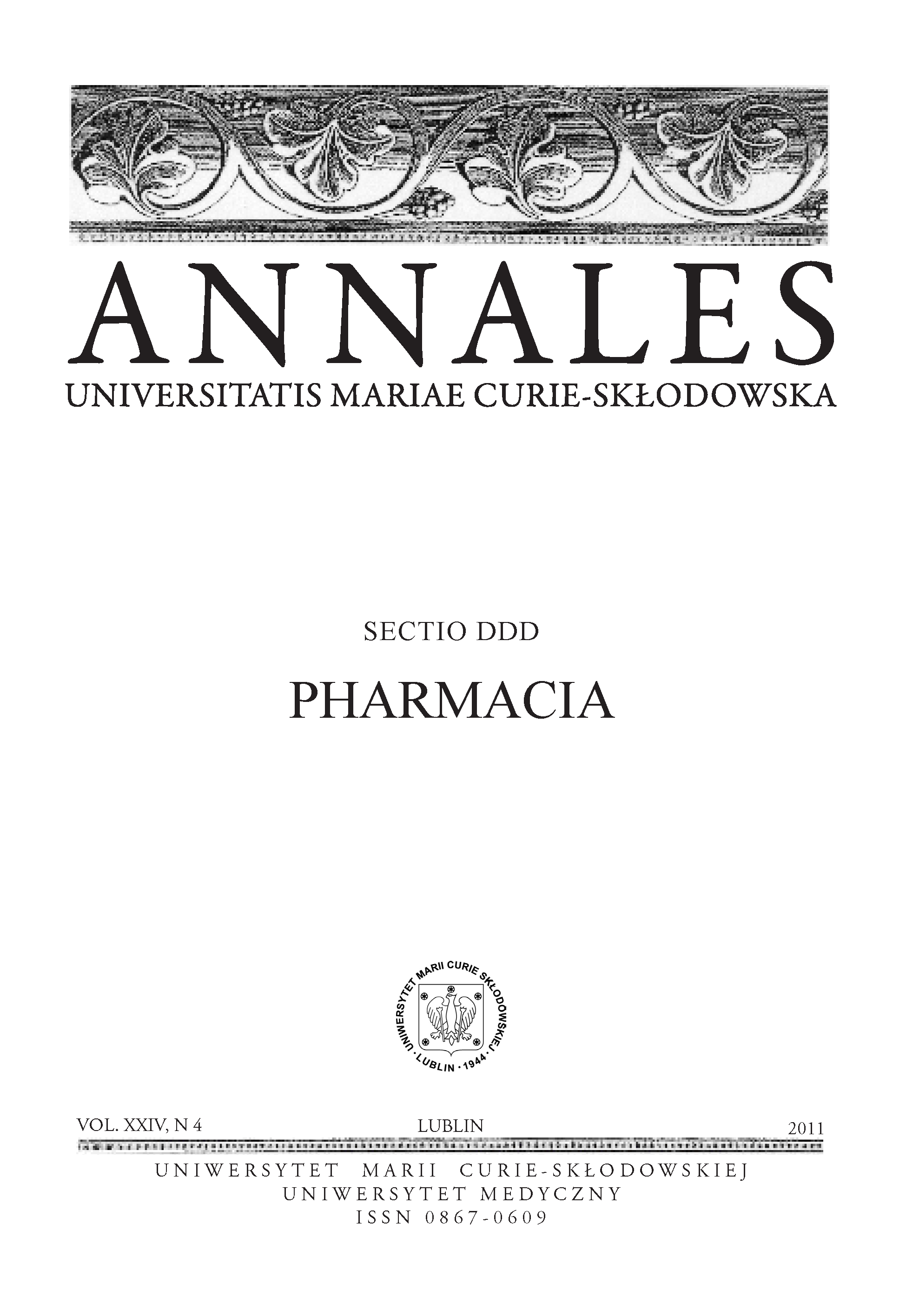α-Fosfoglukomutaza z Escherichia coli ATCC 25922 – badania pilotażowe
DOI:
https://doi.org/10.12923/Słowa kluczowe:
α-fosfoglukomutaza, Escherichia coli ATCC 25922, biofilmAbstrakt
A-fosfoglukomutaza (a-PGM, EC 5.4.2.2) jest enzymem uczestniczącym w metabolizmie cukrów, katalizującym odwracalną reakcję izomeryzacji a-D-glukozo-1P do a-D-glukozo-6P. Badano wybrane właściwości a-PGM z E. coli ATCC 25922. Stała Michaelisa dla a-D-glukozo-1P wynosiła 25 × 10-5 M/L. Enzym miał optymalną aktywność w buforze TRIS/HCl, pH 8.0. Jego aktywność była stymulowana w obecności a-D-glukozo-1,6-bisfosforanu, kationów Mg(II) i kilku tioli. Ciężar cząsteczkowy a-fosfoglukomutazy wynosił 65 kDa, a enzym był zbudowany z jednego łańcucha polipeptydowego. Wykazano znaczącą wrażliwość aktywności enzymatycznej na nie- i organiczne preparaty rtęciowe. Brak hamowania aktywności charakteryzowanego enzymu przez takie chelatory jak: 2,4’-bipirydyl, EDTA i TRIS dowodzi, że a-PGM nie jest metaloproteiną. Zaobserwowano podobieństwa
i różnice pomiędzy a-fosfoglukomutazami izolowanymi z E. coli ATCC 25922 i z innych szczepów E. coli takich jak: ATCC 26 i ATCC 35218.
Przeprowadzone wstępne badania mają istotne implikacje dla lepszego zrozumienia wirulencji enterobakterii (E. coli).
Bibliografia
1. Adhya S., Schwartz M.: Phosphoglucomutase mutants of Escherichia coli K-10. J. Bacteriol., 108, 621, 1971.
2. Belocopitow E., Marechal L.R.: Metabolism of trehalose in Euglena gracilis. Eur. J. Biochem., 46, 631, 1974.
3. Bradford M.M.: A rapid and sensitive method for the quantitation of microgram quantities of protein utilizing the principle of the protein dye binding. Anal. Biochem., 72, 248, 1976.
4. Brautaset T., Standal R., Fjærvik E. et al.: Nucleotide sequence and expression analysis of the Acetobacter xylinum phosphoglucomutase gene. Microbiol., 140, 1183, 1994.
5. Buchanan J.T., Stannard J.A., Lauth X. et al.: Streptococcus iniae phosphoglucomutase is a virulence factor and a target for vaccine development. Infect. Immun., 73, 6935, 2005.
6. Davis B.: Disc electrophoresis. II Method and application to human serum proteins. Ann. N.Y. Acad. Sci., 121, 404, 1964.
7. Degeest B., de Vuyst L.: Correlation of activities of the enzymes α-phosphoglucomutase, UDP-galactose 4-epimerase, and UDP-glucose pyrophosphorylase with exopoly-saccharide biosynthesis by Streptococcus thermophilus LY03. Appl. Environ. Microbiol., 66, 3519, 2000.
8. Dworniczak K., Ginalska G., Patkowska M.: Isolation and characterization of phophoglucomutase (PGM) from Escherichia coli bacteria cells. Ann. UMCS., Sect. DDD, 99, 2008.
9. Hardy G.G., Magee A.D., Ventura C.L. et al.: Essential role for cellular phophoglucomutase in virulence of type 3 Streptococcus pneumoniae. Infect. Immun., 69, 2309, 2001.
10. Ishaque A., Milhausen M., Levy H.R.: On the absence of cysteine in glucose 6-phosphate dehydrogenase from Leuconostoc mesenteroides. Biochim. Biophys. Res. Commun., 59, 894, 1974.
11. Joshi J.G., Handler P.: Phoshoglucomutase. I. Purification and properties of phosphoglucomutase from Escherichia coli. J. Biol. Chem., 239, 2741, 1964.
12. Kvam C., Olsvik E.S., McKinley-McKee J. et al.: Studies on recombinant Acetobacter xylinum -phosphoglucomutase. Biochem. J., 326, 197, 1997.
13. Laemmli U.K.: Cleavage of structural proteins during the assembly of the head of bacteriophage T4. Nature, 227, 680, 1970.
14. Lu M., Kleckner N.: Molecular cloning and characterization o the pgm gene encoding phosphoglucomutase of Escherichia coli. J. Bacteriol., 176, 5847, 1994.
15. Marechal L.R. , Oliver G., Veiga L.A. et al.: Partial purification of some properties of beta-phosphoglucomutase from Lactobacillus brevis. Arch. Biochem. Biophys., 228, 592, 1984.
16. Mehra-Chaudhary R., Mick J., Tanner J.J. et al.: Crystal structure of a bacterial phosphoglucomutase, an enzyme involved in the virulence of multiple human pathogens. Proteins, 79, 1215, 2011.
17. Qian N. , Stanley G.A., Hahn-Hägerdal B. al.: Purification and characterization of two phosphoglucomutases from Lactococcus lactis susp. lactis and their regulation in maltose- and glucose-utilizing cells. J. Bacteriol, 176, 5304, 1994.
18. Schackelford G.S., Regni C.A., Beamer L.J.: Evolutionary trace analysis of the -D-phosphoxemutase superfamily. Protein Sci., 13, 2130, 2004.
19. Sjöberg A., Hahn-Hägerdal B.: β-glucose-1-phosphate, a possible mediator for polysaccharide formation in maltose-assimilating Lactococcus lactis. Appl. Environ. Microbiol., 55, 1549, 1989.
20. Szynal K.: Purification and evaluation of biological role of phosphoglucomutase (PGM) and phosphoglucose isomerase (PGI) from bacteria cells of Escherichia coli. Master’s thesis. Medical University of Lublin, 2008.
21. Yamane K., Ogawa K., Yoshida M. et al: Identification and characterized of clinically isolated biofilm-forming Gram-positive rods from teeth associated with persistent apical periodontitis. J. Endod., 35, 347, 2009.
Pobrania
Opublikowane
Numer
Dział
Licencja
Prawa autorskie (c) 2011 Autorzy

Praca jest udostępniana na licencji Creative Commons Attribution-NonCommercial-NoDerivatives 3.0 Unported License.


